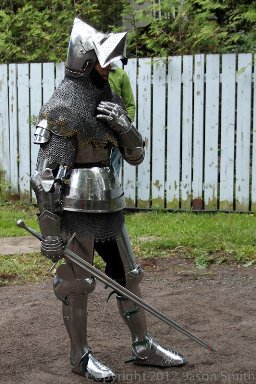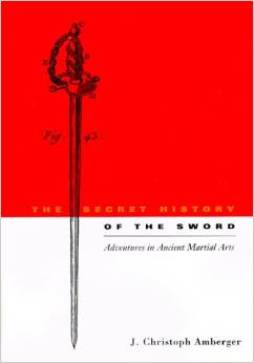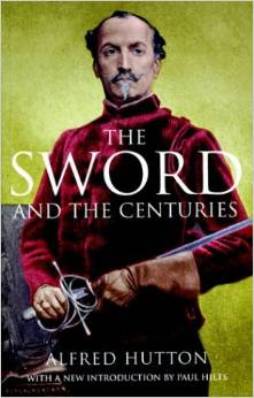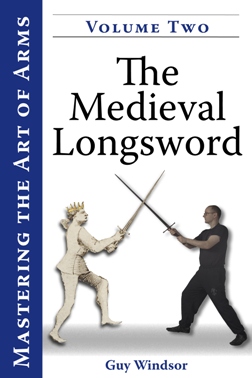Four Books on Historical European Martial Arts (HEMA)

So there are people among us that know how to use historical weapons, that can wield a real sabre, not the bendy car aerial sports variety, have fought in plate armour, jousted, even.
Historical European Martial Arts (HEMA) have already filtered through into Fantasy as authors get sucked into their research — reference Miles Cameron, who fights about as much as he writes. HEMA is also going to pervade Urban Fantasy since… well swords in the city.
And reader expectations are going to raise the barrier.
So, here are some books to help you make sense of it all…

The Secret History of the Sword: Adventures in Ancient Martial Arts by Christopher Amberger
This is a highly polished fixer-up of a well-regarded blog from a few years back.
Very much the scholarly raconteur, Amberger entertainingly ranges from the weapons used by the Germans in the battle of the Teutoburg Forest, through the experience of real combat, to the history of fencing for (often painful) sport.
He also narrates his adventure with modern German Academic Fencing and how he got his dueling scar.
Read this book for an enthusiastic and well informed tour of the history of sword fighting with special reference to the cool bits.
The Sword and the Centuries by Alfred Hutton

An old book that should really be entitled, “Testosterone poisoning through the ages.”
It’s about all the macho and unwise things swordsmen (and axemen) did just for the hell of it…
…Medieval tournaments fought with sharp poleaxes; the French 17th century dueling craze that threatened to wipe out a generation of young aristocrats; and the long slow death of sword dueling in Britain, involving a fair number of stabbings and hangings, until it was stomped out.
A fencing instructor to the Victorian British Army at a time when people still used swords in battle, Alfred Hutton was one of the first vaguely modern folk to look at old sword manuals and try them out, and surely one of the last HEMA practitioners to have taught the use of sabre as a primary military weapon for real. This makes him some kind of “missing link”, albeit with a higher forehead and less facial fur.
Hutton wrote several books drawing people’s attention to the original sources and defending old swordplay against the received wisdom that it was crude and unsophisticated. He also wrote a very good dueling sabre manual still used by HEMA folk today. (A friend of mine refers to him as the Sainted Hutton and solemnly celebrates his birthday.)
Read this book to get an entertaining insight into the Western warrior mentality, which turns out to be somewhere between gunfighter and gangster and — when you read the dueling stories — not entirely attractive.
Academy of Historical Arts: German Longsword Study Guide by Keith Farrell & Alex Bourdas

This short handbook covers what we moderns know about German Longsword –the best documented of European Medieval Martial Arts – and how we know it, with descriptions of the various techniques that might be eye-opening if you think Medieval fighting was all about grunting and shoving.
(Flicking through the pages, it’s clear that German Longsword has at least one advantage over the Italian Longsword style that flourished at the same time; German terminology is just more Metal!)
(You could name your band Zornhau after the diagonal cut, while the Italian equivalent, Mandritto Fendente, sounds like something you’d put on your pizza. There is actually a band called Krieg — the fighting that happens when the blades are crossed — while the Italian analogue, zogho stretto, could be a 19th-century Balkan ruler.)
Being a study guide, it’s not fully illustrated; it assumes you’ve already started looking at the medieval fencing manuals now readily available online. It’s also not a “teach yourself book”, though there are useful and informed discussions of issues like stance and how to attack.
Despite his terrifying relative youth, Keith Farrell is a well-traveled professional historical fencing master, and one of the founders of the massive Glasgow-based Academy of Historical Arts, where Alex Bourdas is an experienced instructor.
Read this book for a glimpse into a well-documented Late Medieval martial art, and for a sense of what the HEMA movement is up to. (If you’re already a practitioner, this will enable you to open your mouth in pub discussions without sounding ignorant.)
The Medieval Longsword (Mastering the Art of Arms Book 2) by Guy Windsor

I’ve saved the best for last, I think.
To me, this is probably the most significant book on longsword since AD1600. It’s basically teach-yourself longsword with special reference to the work of Fiore de Liberi (1360-c1420), a fencing master during longsword’s battlefield heyday.
Guy Windsor makes his living teaching Medieval Italian Longsword and other historical martial arts to Finns in Helsinki — think, Moomins with big swords — touring the world doing the same, and providing fight choreography for screen and game projects. He’s also a true renaissance man, with a passion for body mechanics and a wide knowledge of martial arts, both eastern and western. And that’s what makes this book so excellent. He doesn’t just show you techniques; he tells you how to think about them, conveys how they should feel, and puts them in their martial context.
Guy is also an excellent writer, a true heir to the enthusiastic antiquarians of times gone by. He’s also — as you might guess from the introduction by Miles Cameron — one of us, essentially swordmaster to the Heroic Fantasy folk.
(He talks like he writes, so if you ever get the chance, buy him a beer or two and ask him questions.)
Read this book to get a taste of what it feels like to be a swordsperson and perhaps to start learning to use one…
* * *
…though if you’ve read this far, then I’m guessing you can truly hear the song of steel! Open a new browser window right now and Google HEMA for your area.
M Harold Page (www.mharoldpage.com) is a Scottish-based writer and swordsman with several Historical Adventure franchise books in print. His creative writing handbook, Storyteller Tools is available on Amazon. If you live near Edinburgh, Scotland, he would love to teach you how to fight in Medieval German Longsword style.
Read this book to get an entertaining insight into the Western warrior mentality, which turns out to be somewhere between gunfighter and gangster and — when you read the dueling stories — not entirely attractive.
As opposed to all of those unambiguously and entirely attractive non-Western warrior mentalities…
LOL yes, point taken. It’s just that rapiers have that Thee Musketeer Vibe LOLsmite vibe. Then you read about young men going out for a drink with friends, happening on a 3 vs 3 duel where one man has dropped out and helping out by making up the numbers, then getting killed. Nuts!